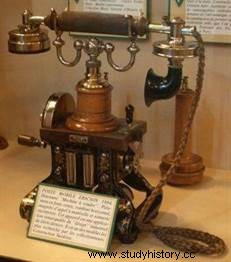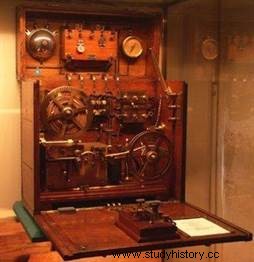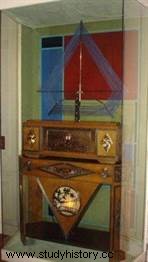
Located in the agglomeration of Angers, within the domain of Pignerolle, the Château-Museum of communication of Angers offers since 1992, an educational and interactive vision of the history of the means of communication . The innovations on display constitute a total of 1300 devices , including among others radios, televisions, telegraphs . Through interactive workshops and excerpts from broadcasts of the time, you will be able to discover the great inventors who have shaped the history of the media.
It is thanks to Guy Biraud, founder of the Museum, that the establishment acquired a collection of 1300 preciously accumulated and restored devices. The museum is organized into different spaces representing the evolution of innovations. Each space is assigned an inventor name. Before the start of the visit, an audio guide system with headphones and a game booklet are available for adults and children. The route includes exhibitions of devices, film extracts, reconstructions of cult scenes as well as experiments to be carried out.
A first trip to the beginnings of communication
The first workshops focus on the primary means of communication such as speaking and writing. Among the exhibits is a Sumerian tablet from the 4th century . You should know that the Sumerians were the first to use cuneiform writing, which consists of acronyms in the shape of nails and wedges. The beginnings of printing in the 1450s are the brainchild of German inventor Johannes Gutenberg. You can admire a 19th century American press that bears witness to the progress of this invention.
 Another important invention:the birth of electricity. Alessandro Volta present in 1799 its electric battery to Napoleon 1
st
. Evidenced by the reconstruction of the famous electric kiss to spark a spark between the partners. Playful manipulations offer the opportunity to test electromagnetism and static electricity. Electricity opens the way to many inventions, such as telephones and period cameras on display.
Another important invention:the birth of electricity. Alessandro Volta present in 1799 its electric battery to Napoleon 1
st
. Evidenced by the reconstruction of the famous electric kiss to spark a spark between the partners. Playful manipulations offer the opportunity to test electromagnetism and static electricity. Electricity opens the way to many inventions, such as telephones and period cameras on display.
Thereafter, you will have the pleasure of discovering the ancestor of the SMS. This is the first device capable of transmitting a coded message remotely. This invention comes from Samuel Morse who sent in 1844 a telegram, between Washington and Baltimore. Wireless telegraphy made its appearance in 1889, thanks to Eugène Ducretet who transmitted signals from the Eiffel Tower to the Panthéon.
A dynamic presentation of modern media
The advent of cinema is presented through the broadcast of the first films of the Lumière Brothers such as Leaving the Lumière factory in Lyon or the arrival of the train at La Ciotat. The session, which lasts 15 minutes, was screened for the first time on December 28, 1895 , in the basement of the Grand Café, boulevard des Capucines, in Paris.
The Beginnings of Radio in the 1920s and its evolution are illustrated by a showcase comprising authentic radio sets, in particular the Galène set from the 1920s. Within this space, it is possible to listen to extracts from programs hosted by Jean Nohain such as The unbeatable , Mireille's Friends Lounge or Queen for a day .
A collection of TV sets highlights the beginnings of this flagship medium. In France, the first broadcast was broadcast on April 26, 1935 . You can see excerpts from TV shows like Intervilles or Good night kids, created in 1962.
Video:the arrival of the train at La Ciotat station
An original end to the visit with a fantastic and spatial dimension
 An original touch punctuates the visit and plunges the visitor into the world of Jules Verne> and George Wells. The living room of the famous submarine:the Nautilus and the ancestor of television from the "Castle of the Carpathians " have been re-enacted. War of the Worlds , a work by Georges Wells, father of modern Science Fiction, is honored through a fantastic setting composed of two extra-terrestrials.
An original touch punctuates the visit and plunges the visitor into the world of Jules Verne> and George Wells. The living room of the famous submarine:the Nautilus and the ancestor of television from the "Castle of the Carpathians " have been re-enacted. War of the Worlds , a work by Georges Wells, father of modern Science Fiction, is honored through a fantastic setting composed of two extra-terrestrials.
The visit ends with the theme of space. A film presents the history of the space conquest and the technological competition between the United States and the USSR through the first satellites. It also evokes Neil Armstrong's first steps on the moon on July 20, 1969 . You will be able to discover the interior of the capsule Apollo 11 which has been rebuilt. Interactivity is always in order because an experience open to all makes it possible to measure the speed of sound.
The Pignerolle area in Angers offers a favorable setting for walks and the organization of events. It has a 70-hectare park and an orangery, both classified as historical monuments. Carriage rides and child-friendly tours are organized throughout the year.
Practical information for the castle-museum of communication in Angers
- Opening: every day from 10 a.m. to 12:30 p.m. and from 2:30 p.m. to 6:30 p.m.
- Rates :5.50€ or 4.70€ for students and 2.50€ for those under 18.
To take a virtual tour of the Château-Musée d'Angers, click here.
- The site of the castle-museum of communication in Angers
